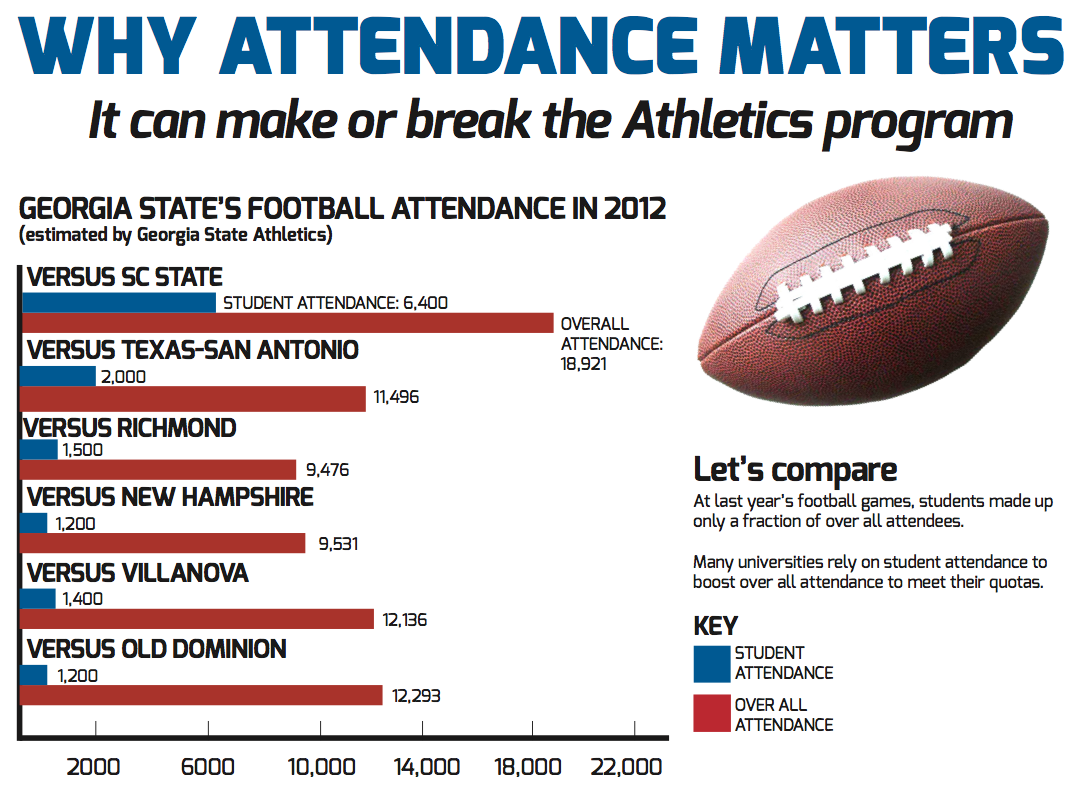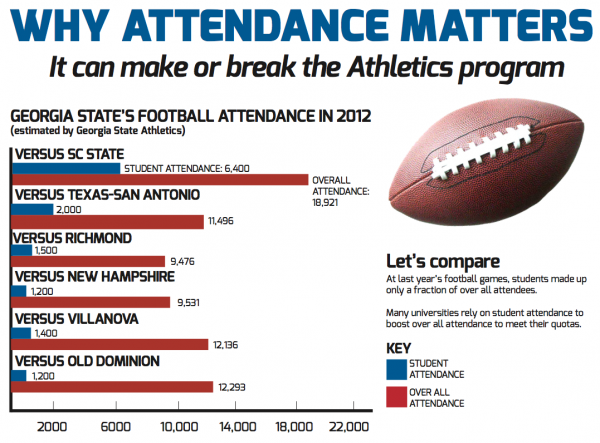
What do you think was the average attendance for Georgia State football games for the 2012 season? 3,000? 6,000? Surely it was not more than that.
Wrong.
The average attendance per game at Panther football games was 12,309 last year.
In fact, Georgia State was ranked No. 21 in average home game attendance last year in the FCS, according to the NCAA.
The staggering statistic isn’t the overall average attendance, but the student attendance.
Last season, the average student attendance at football games was 2,283. That’s less than 19 percent of the overall average attendance and roughly 7 percent of all the students enrolled at Georgia State.
With Georgia State now being in the FBS, this adequate average will not suffice as certain attendance requirements must be met to sustain FBS status.
Student attendance is the statistic that hurts attendance substantially.
The importance of students
Students get in free to all home Georgia State athletic events. At least that’s what they think.
Students who are enrolled in six or more credit hours pay 263 dollars a semester for the athletic fee.
Think of that as the cost of your admission to all the athletic events, especially football.
Students are one of the most important factors in attendance, according to Georgia State’s Assistant Director of Marketing, Matt Newhouse.
“Students will make or break our season on every part of it, every level,” Newhouse said.
Student attendance at games not only makes a program look like it has ample support, but also boosts the overall average that must meet a required quota in the FBS.
FBS members must average 15,000 in average attendance once in a rolling two-year period of time. Failure to do so could put the program on probation for up to 10 years. If it persists, it could lead to a complete bowl ban on the program.
For most colleges, students are an easy way to meet this requirement, but not for Georgia State.
“If you look at what ticket sales are compared to what attendance and numbers are across the board in college athletics — you have to have your student numbers there to support your program, be able to hit your numbers and not be put on probation,” Newhouse said.
Bringing in students is the goal for the Sports Marketing Department, even if they have to drop money from the sky or bring in Georgia State alum Ludacris to attract the students. They just want to meet the quota.
The disingenuous Georgia Dome
The Georgia Dome is a nationwide recognizable sports venue. Some of the biggest sporting and entertainment events of the year take place there.
For Georgia State, it is home.
Coaches see the Georgia Dome as a recruiting tool, and players see it as an opportunity.
However, the marketing department sees the Georgia Dome as a factor that hurts the fan experience.
Some components of the Georgia Dome help the department with marketing such as the LED screens for advertising and the ability to do promotions on the field.
Consequently, the daunting size of the Georgia Dome is a pitfall they cannot overcome.
“As a fan you sit there, even with 20,000 people in that lower bowl, you’re still going to look up at all the empty seats,” Newhouse said, as it creates a sense that no one is there.
The marketing department has tried to come up with options to help remove the visual allusion of sitting in an empty stadium, but none of them are fiscally feasible.
Options such as hanging large curtains to cover the upper decks or seats are not some- thing the department can or is willing to spend money on.
“The money is spent on much better things than to improve that one part of football.”
Marketer Miles
Trent Miles works closely with the Sports Marketing Department to support them and get involved in any way he can to promote the team.
Newhouse and Parker agree that Miles is more involved in the department than any other coach in college football.
“At Indiana State, he was the marketing guy,” Hendricks said. “We’ve actually had to pull him back a little.”
Miles loves to go out and speak to groups to get the word about Panther football and gain support.
Hendricks said the department used to joke “if Yankee Candle wanted him to come speak to a bunch of women about candles, he’d be there just because that’s what he did at Indiana State.”
Miles makes being involved with marketing a top priority as he knows the repercussions of not meeting the FBS attendance requirements and keeps the department on their toes, according to Hendricks.
“He’s a blessing in disguise,” Parker said.
Where the real money comes from
Students are important, but they don’t bring in money like the ticket holders do.
“We have to sell tickets, if we don’t sell tickets and don’t make any money and we can’t have a football program,” Newhouse said.
Newhouse said that it would be hard to support other Georgia State sports that don’t acquire as much revenue as football, if any.
“People aren’t paying to go out to cross country meets, but they still compete,” Newhouse said. “They’re just as important as student-athletes as anybody else. So we need to make sure we’re able to support them, let them travel, [and] go out in tournaments but we need the money from football to support that program.”
The Sports Marketing Department must work then not only to attract the students, but attract alumni, parents and sports fans to games to buy tickets and bring in money for all Georgia State sports.
The idea behind #AllBlueAllIn
With students and ticket holders being important to the marketing department, they sought after a way to unite the Georgia State community through social media, and let their messages get out.
Parker Hendricks, a graduate assistant for the sports marketing department, told The Signal about the creation of the hashtag AllBlueAllIn and why it is important.
“Last year you would have a football game [and] use the hashtag #GSU. We’re getting Georgia Southern [or] Grambling
State. #PantherNation we’re getting Carolina Panthers,” Hendricks said.
The creation of the hashtag had to be carefully thought of to be simple, but original to avoid being mixed up with other hashtags.
“The color blue is something that separates [Georgia State], especially from Georgia Southern and University of Georgia and even Georgia Tech because they focus more on gold stuff of what they do than anything else,” Newhouse said.
“We can really focus this [hashtag] being our brand and who we are and our identity.” Newhouse said he is pleased that the hashtag has become more than just the marketing hashtag, but has expanded to being the “University’s hashtag.” “#AllBlueAllIn, we’re controlling the conversation,” Hendricks said.

